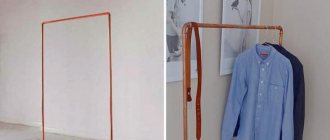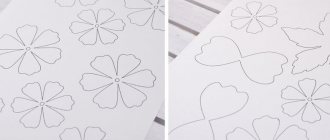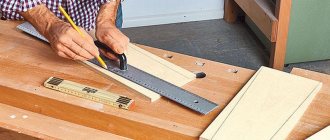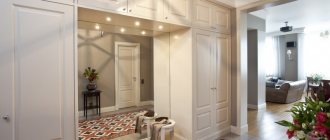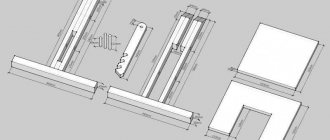Measurements and calculations
Before drawing up a drawing, you will need to take correct measurements. Since niches, walls and corners of modern housing rarely have regular geometric shapes, measurements should be taken using a certain algorithm:
- first of all, you need to measure the back wall: upper part, middle and lower levels;
- then the façade is measured taking into account the setbacks.
Measurements should be taken at three levels from the back and front.
It is important to understand that installation without preliminary measurements can cause problems. There is a possibility that the cabinet frame simply will not fit into the space provided for it. In addition, large gaps may form in the joint area.
Corner wardrobe requires measurements:
- along the back on both sides, which extend from the corner;
- sides;
- the front side along the corner facades.
Popular styles and colors for wardrobes in the living room, examples of placement
If you want to place furniture in a niche, it is important to measure the sides that will go into it - all calculations must be done in three levels, even if the cabinet is planned to be made to cover the entire wall, and a corner will be involved.
Cabinet width
Height
Depth
Preparatory work
To create a built-in wardrobe for your bedroom with your own hands, you need to cut it out, prepare all the parts, and then assemble it. It is better to order cutting of laminated chipboard according to drawings (specifications) and edging of parts in a workshop or cutting service at a construction supermarket. At home, using hand tools, it is difficult to make a neat cut and accurately maintain the dimensions. But in order to save money, you can cut the blanks yourself. If a built-in closet without walls is being assembled, the shelves and partitions still have to be sawed down immediately before installation in place to eliminate the gaps that arise due to the curvature of the walls. Therefore, it is better to carry out preliminary cutting with a margin of up to 2 cm.
The optimal slab thickness for internal filling and doors with a double-rail suspension is 16 mm, for doors with a monorail - 25 mm. To seal the visible ends, use a U-shaped profile made of PVC, less often made of aluminum, and a melamine self-adhesive edge. The rods are made of metal pipe with a diameter of 25 mm. Assembly begins with the internal filling and ends with hanging the sashes. To prevent the walls and ceiling from becoming dusty, they are cleaned of the old coating, impregnated with PVA emulsion (applied with a roller) in 2-3 steps at intervals of a day, and then painted with acrylic enamel. Before proceeding with installation, you need to make markings on the prepared walls.
Step-by-step instructions for assembling sliding doors
- The cabinet opening guards are checked for correct horizontal and vertical position using a level and plumb line. Deviations are eliminated. (link: DIY wardrobe)
- Aluminum profiles are marked with a tape measure and a marker into the required sections.
- Cut the profiles with an ordinary hacksaw for metal. Make very carefully so that the cuts are strictly perpendicular to the longitudinal axes of the aluminum parts.
- Mounting holes are drilled in the frame racks from the outside. Two holes are made at the bottom - one for fastening to the lower frame bar, the other for fastening the rolling mechanism (roller). One hole is made on top for installing a self-tapping screw.
- Install the upper and lower guide strips. Using a narrow drill, drill holes through the profiles in the cabinet slabs. Then the rails are secured with self-tapping screws and a screwdriver.
- Spring stoppers are inserted into the groove of the bottom bar on both sides.
- Mirrors of the required size are cut out with a glass cutter or entrusted with this work to a master.
- Sheets of laminated chipboard or MDF are marked with a marker.
- The canvas is cut out with a jigsaw. If possible, it is better to do this with a band saw or circular saw.
- A silicone tape is placed with a groove around the perimeter of the finished filling. At corner joints, excess silicone is cut off with scissors.
- One rack is fastened with a self-tapping screw to the top bar of the frame.
- A canvas or mirror is inserted into the corner of the frame.
- Attach the bottom bar to the side handle so that the blade fits tightly into the groove.
- After this, the frame is closed by installing a second rack.
- Before final tightening of the screws, the brackets of the upper horizontal rollers are inserted under their caps. The fasteners are tightened with a wrench.
- Set screws secure the two lower support rollers into the groove of the lower frame rail.
- The buffer tape (schlegel) is pulled into the side grooves of the racks, after first removing the protective strip from the self-adhesive base.
- Schlegel closes the mounting holes. The top and bottom of the schlegel can be secured with special clamps.
- In the case of assembling a combined filling, the upper, middle and lower strips are attached to one rack.
- Fragments of filling are inserted into the grooves of the frame from the side.
- Then the second stand is attached to the transverse bars.
Assembly steps
After all the details are prepared, you can proceed to the most important step - assembling the wardrobe. At this stage you will need:
- level;
- rubber and regular hammer;
- corner;
- screwdrivers;
- roulette;
- pencil;
- screwdriver;
- drills for wood and metal.
In order to get started, you need to decide on the assembly steps. Most of the cabinets are assembled according to the standard scheme:
- base;
- frame;
- rear wall installation;
- installation of shelves and guides;
- hanging doors.
The final step will be to install additional internal components: pull-out baskets, drawers, etc.
Box
A homemade box must be assembled from the bottom. Step-by-step instruction:
- we mark the place where the base will be installed (legs are often used instead of base strips, but they also require markings);
- we make holes for fasteners, attach the bottom using self-tapping screws and corners;
- We assemble the transverse supports of the plinth.
Adjustable legs are easier to install: the plastic plugs are cut off with a knife and the supports are screwed into prepared holes of the required diameter.
To mount the housing:
- Build the box in a vertical position. If you put it down, the structure may become distorted. It is important to leave at least 100 mm for installing the roof.
- Make holes in the bottom for anchors and install them - this is where the strips will be fixed.
- Mount the panels (you will need an assistant at this stage). First of all, the side part is installed on the left side, it should be held, after which the right side wall is secured.
- Install the middle part (if any), and then the roof, which should be placed on the corners or confirmations.
Characteristics of sliding wardrobes with 4 doors, popular models and designs
A step-by-step algorithm is also provided for mounting the rear wall:
- Install the panel on the back of the product.
- Carefully holding the shield, secure it with self-tapping screws. They are tightened with a screwdriver or screwdriver at a distance of approximately 10–20 cm.
If the cabinet has several back walls, the elements should be fastened end-to-end. In this case, it is necessary to use special fasteners that will tighten the parts, and then screw self-tapping screws onto the back plate.
Storage system installation
After checking the stability of the case, you can equip the storage system. To install, you should follow this algorithm:
- The shelves will be fixed using corners and self-tapping screws, so first of all, holes are drilled on the parts.
- Mark the location of the shelves, and then attach them to the side and middle racks.
- The rod is inserted using a special flange that comes with the part. It is attached to the walls with self-tapping screws. If necessary, the rod can be shortened using a hacksaw.
The last step is to secure the drawer and basket guides, after which they can be inserted.
Installation of a sliding system and hanging facades
First you need to fix the guides, do this using self-tapping screws. It is important to install them strictly in a straight line, otherwise there will be problems with sliding doors. Correct assembly of the cabinet assumes that the upper rails are fixed level with the front end of the sidewalls, while the lower rails should deviate from them by 8–15 cm.
The facades are hung last. In this case, the sash is first secured, which will move along the rear rail. Then other doors are installed. To install them, it is necessary that the rollers on the panels fit into the grooves on the guides. After installation, it is important to check the movement of the doors and the tightness of their fit to the side parts of the body. The completion will be the fixation of stoppers, which will prevent the sash from jumping out of the system.
How to start making homemade wardrobes
Most novice carpenters do not start with a cabinet with their own hands in the apartment, but make a rough version of the furniture. After all, even making a simple built-in wardrobe for a loggia yourself is quite difficult. Therefore, if you start with a simple cabinet on a loggia, balcony or cottage, you have an excellent opportunity to gain experience. In addition, such a piece of furniture will be very useful as an additional place to store things that are not afraid of the cold, and if the loggia is insulated, then you can easily store items.
It is much more difficult to make a cabinet on a balcony or loggia, since its design is different. But if you succeed, then after that you can safely begin improving your apartment. After all, making a cabinet with your own hands will be a simple task for you. Therefore, all beginners are advised to start by making cabinets for the balcony, as they may have some flaws, but they will not be noticeable.
In addition, you can build a door in the country if you do not want to spoil the interior of your balcony, since a small storage room with sliding doors will always be of minimal use to you to store garden tools.
Don't expect to do everything perfectly the first time. Making even a simple stool so that it looks beautiful is not as easy as it seems at first glance. Firstly, you need to have experience in carpentry, and secondly, you need to try so that everything works out for you. And for a do-it-yourself cabinet, you will also have to show a lot of ingenuity, since the door mechanism is quite unique, and installing it is a rather labor-intensive task.
